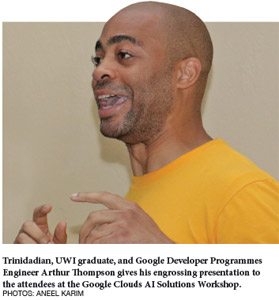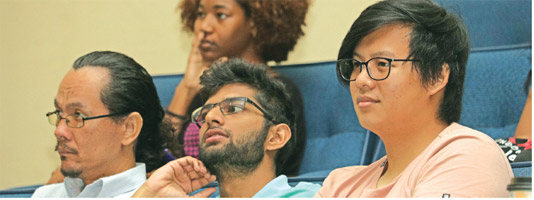

YouTube, Android, Gmail, Chrome, Google Play Store, and Google Maps are Google’s biggest products with more than one billion users. This makes the tech giant one of the world’s largest companies. Now they are recruiting in Trinidad and Tobago.
“I’m looking forward to many more resumes from UWI in Trinidad and Tobago,” said Valentine Fontama, AI (Artificial Intelligence) and Machine Learning Practice Lead at Google’s Professional Services. Fontama added, “20 years ago when I was doing my PhD research on AI, I couldn't imagine I would live to see the day when AI and machine learning are being applied in the mainstream.”
On Thursday, June 6, representatives from the company came to UWI St Augustine campus to participate in a workshop on Google Cloud’s AI solutions, to speak about Google’s products and employment opportunities.
An eager and interested audience filled Lecture Theatre 1 in the Faculty of Engineering’s (FoE) Max Richards Building to get a glimpse of life working for Google and to hear about the work they are doing with machine learning.
“This is the largest lecture theatre in the faculty and it is very comforting to see this lecture theatre very well populated, particularly when the semester is not in session,” Dr Sanjay Bahadoorsingh, FoE’s Deputy Dean of Enterprise Development and Outreach said. “It is clear that there is a keen interest in the application of machine learning. It is also an acknowledgement of the potential opportunities for new jobs that exist in today's world.”
Landing a job with a tech giant like Google may seem like nothing more than a dream but for two UWI alumni, Arthur Thompson and Stefan Hosein, this dream became a reality.
Thompson recalled that while in his undergraduate and postgraduate studies at UWI he was always trying to build projects of his own. He is now a developer programmes engineer at Google. Thompson said, “I still consider myself very much a UWI boy.”
In his time at Google, Thompson worked on RecyclerView for Android devices and currently works on Firebase, Google’s mobile app development platform. Thompson demonstrated some applications he created using Firebase. One had a local touch. He made a machine learning model to identify the presence of mangos in photographs.
Thompson said, “I decided I would do a doubles ML model to identify doubles because I love doubles.” He explained that the model did not work because he uploaded too few images of the doubles, 50 instead of the recommended 100. By the time Thompson recognised this error he had already eaten his doubles so decided to switch to mangos instead. The application was successfully able to identify the presence of a mango in an image.
Hosein, a machine learning cloud engineer, began by clearing up what artificial intelligence is, and isn’t. He separated fact from science fiction and explained how machine learning, a type of artificial intelligence, worked.
Using Gmail as an example, Hosein explained how Google uses machine learning to filter spam emails. He said the advantage of this is that the AI can learn from every piece of spam mail collected thereby being able to better differentiate between spam and not spam.
Hosein covered some of Google’s applications that use machine learning,for example Google Photos, which saves photos in the cloud and allows users to search their images. “You can just type puppy in, and you will get all of the pictures of your puppy,” Hosein said.
For people wanting to try their hand at machine learning, Hosein recommended Colaboratory, an online notebook where you can write and execute code.
 Technology was king that day and Fontama, Rachael Deacon-Smith, and Brandon McCutchen joined the workshop via Google Meet, a video conferencing application. Technology was king that day and Fontama, Rachael Deacon-Smith, and Brandon McCutchen joined the workshop via Google Meet, a video conferencing application.
Deacon-Smith, a data strategic cloud engineer, pointed out that at Google, “there is so much to learn, it's always changing, it's changing every week. There is no way you’re going to know everything.”
She spoke about how she came to work at Google and her experience as a female of colour in an industry that can sometimes be dominated by “white males”.
Deacon-Smith stressed taking advantage of opportunities when they present themselves as the may lead to even greater opportunities. She explained that when she applied to Google, she did not have much experience with interviews and applications and that she met her current supervisor at a networking event.
McCutchen, a Google University programme specialist, spoke about some of the jobs offered at the company and described the application and interview process.
He described what Google recruiters look for when hiring people fresh out of school looking for jobs or internships, and also people who have been or are currently employed elsewhere. He gave resume tips such as having the file in PDF and the type of words to use in the resume and described what one could expect in the lengthy interview process.
Marc Kanneh is a final year strategic communications student from the Florida Institute of Technology interning at the Marketing and Communications Office at The UWI St Augustine Campus. His interests include running and cooking.
|





